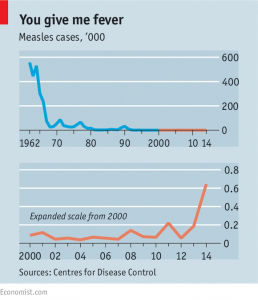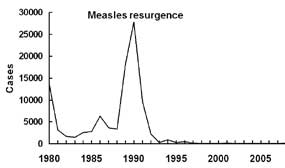Spotty coverage
Here’s a graph from the Economist showing the impact of the measles vaccine:
The number of measles cases fell from over half a million per year to about 100 per year when the vaccine was introduced. That’s a 99.98% reduction, in a disease that (in a healthy population) kills about two people in a thousand.
Here’s a graph from the Centers for Disease Control showing that little blip in 1990 on an expanded scale:
They say
The most important cause of the measles resurgence of 1989–1991 was low vaccination coverage. Measles vaccine coverage was low in many cities, including some that experienced large outbreaks among preschool-aged children throughout the early to mid-1980s. Surveys in areas experiencing outbreaks among preschool-aged children indicated that as few as 50% of children had been vaccinated against measles by their second birthday, and that black and Hispanic children were less likely to be age-appropriately vaccinated than were white children.
Vaccine coverage isn’t as bad as that now, but the profile of unvaccinated kids is different. Black and Hispanic children are just as likely as white children to have had at least one doses of the measles vaccine, and children in poverty have a rate only 1.5 percentage points lower. Now, a substantial chunk of the problem is parents who are anti-vaccine.
Kieran Healy has an interesting post on the ‘personal belief exemption’ data for kindergarten children in California. They are only 3.36% of children, but they cluster. That’s important because US is just on the edge of having high enough vaccine coverage to stop an epidemic from spreading, at least if the unvaccinated were evenly spread through the population. They aren’t:
the number of kindergarteners with PBEs, even in Berkeley, is not huge—about 67 kids out of 850 in the city. But 20 of those 67 are in the same school, and probably the same room.
Anti-vaccine hysteria is more prominent in the US than New Zealand: partly because our mainstream media don’t go in for it, and partly because everything is more prominent in the US. Similarly, reaction to the risks posed by unvaccinated children has been more prominent in the US. However, New Zealand has a similar rate of measles vaccination. Our schools or early childhood services cannot refuse enrollment based on vaccination (no special paperwork is required as in California), and (like California) can only temporarily exclude unvaccinated children if they are known to have been exposed.
Last year, New Zealand had 283 cases of measles. Scaled for population, last year in NZ was about half as bad as the US in 1990, and about thirty times bigger than the current US outbreak (so far).
Thomas Lumley (@tslumley) is Professor of Biostatistics at the University of Auckland. His research interests include semiparametric models, survey sampling, statistical computing, foundations of statistics, and whatever methodological problems his medical collaborators come up with. He also blogs at Biased and Inefficient See all posts by Thomas Lumley »


Thomas – great post, thanks! The hysteria on Twitter about the measles epidemic is pretty intense!
Can you find the number of cases of measles in NZ in the 1985 outbreak? I remember so many people having it then, when I was at primary school. I can’t seem to locate it online – but it felt like it would have been many more than ~400 cases.
10 years ago
I don’t have figures for the 1985 epidemic (and measles wasn’t a notifiable disease then).
The 1997 epidemic was about 2200 cases, thanks to an emergency vaccination campaign.
A mathematical model fitted to previous epidemics predicted 45,000 cases without the additional vaccination campaign — presumably the previous epidemics were of about that size.
10 years ago
Thanks Thomas – that explains why I couldn’t find the info online!
10 years ago
How do things stack up if you just looked at California?
10 years ago
California measles vaccination rate is about a percentage point lower than the US as a whole, but there’s a lot of uncertainty in that number (National Immunisation Survey).
If you mean using the California rather than US population: California is still 34 million people, so NZ was still way worse per capita.
10 years ago